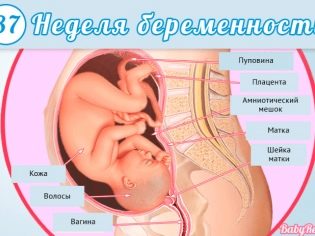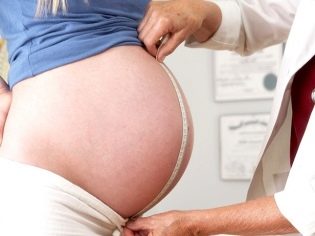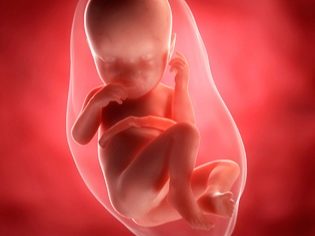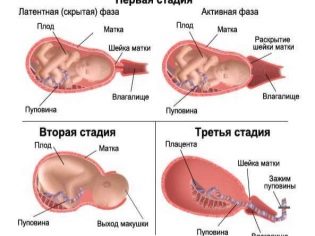Harbinger delivery at 36-37 weeks of pregnancy
36-37 weeks of pregnancy is usually associated with the beginning of the active preparation of the female body for the upcoming birth process. This preparation is comprehensive and global, a huge number of changes occur in the body of the future mother, the purpose of which is to facilitate the onset and successful progression of labor.
In this article, we will talk about how precursors of labor can be this week, as well as whether the appearance of precursor symptoms is normal a month before the date of birth.
Features of the current term
36-37 week of pregnancy opens a new stage in the life of the expectant mother. A prenatal period starts, during which a large internal preparation for the upcoming reflex act of childbirth begins. Do not be afraid even if labor starts at 37 weeks, the baby will be considered full-term, and childbirth themselves will not be considered premature, as at 37-38 weeks.
However, childbirth at 35-36 weeks and at 36 weeks is still hasty and can be associated with certain risks for the mother and baby.
Until the estimated date of 36-37 weeks is still about 3 weeks, and therefore there is time to finish all the important things and tune in to the easy birth of the baby. but PDR - the term is not mandatory, and only every 20th baby appears on this day. The rest of the children prefer to be born either earlier or later than the date specified in the medical card of the pregnant. If the birth is coming first, then there is a chance that the baby will appear after the 40th week, and if the second or third, then it should be understood that the baby can “ask for” outside on any day this week or next week.
Women in the current gestation period are usually already waiting for impatiently for signs that should appear in the run-up to the birth of a baby. It becomes more difficult to wear a pregnancy every day, and therefore some impatience of the future mother is quite understandable.
It is this week for many that becomes a “turning point”. If earlier it was difficult to breathe, the ribs ached, tormented by heartburn, then the active preparation of the body this week can bring pleasant surprises - it will become much easier to breathe, because many people have a full stomach in the full 36 weeks.
Common symptoms
As already mentioned, the main symptom this week may be a change in the shape of the abdomen and a decrease in the height of the uterus. This is due to the fact that the child occupies the correct "prestarting" position in the uterus: it goes down and presses the head against the internal throat, thereby putting additional pressure on the cervix, which also begins to mature.
At 36 weeks, the abdomen is usually lowered in primiparas. Women who carry a second or third child under the heart normally mark such a precursor only a week before giving birth or even a couple of days before the process begins. Therefore if not the first childbirth is coming, and in the current term the baby has dropped, you should be extremely careful, childbirth can begin at any time. Primiparous with a lowered belly can perfectly carry the child for another 3-4 weeks.
Waiting for the omission of the abdomen is not worth it if the pregnancy is multiple, if polyhydramnios is detected or the fetus is in the wrong way.
The omission is indicated by:
- abdominal shape change;
- easier breathing, dyspnea reduction;
- frequent urination due to fetal head pressure on the bladder;
- increased pain in the pubic joint, in the pelvic bones.
At 37 weeks of movement, it becomes less.They are not as active as before, but still future Mom needs to count the movements of her crumbs. If they are less than 10 in half a day, you should definitely inform your doctor.. A sign of speedy childbirth is not considered to be less fetal activity at this time, the reason for this behavior of the baby lies in substantial cramping, because it occupies the entire uterine cavity. Prenatal "calm" in the stomach, when the child reduces activity to a minimum due to the need to accumulate strength and energy for the birth process, usually starts 1-2 days before the onset of labor.
This week, a woman may pay attention to strengthening the training bouts. They are irregular and short-term tension of the uterine muscles. This is not childbirth, coping with them is easy - you can take a shower or drink a pill "No-Shpy", change the position of the body, take a walk, work out breathing exercisesand the fight will recede.
For multiparous training contractions usually begin one week before the birth of the baby, for primiparas, they can be observed from the 20th week of pregnancy. False contractions, more frequent than before, should not scare the expectant mother - in the uterus and the endocrine system there are many physiological processes with which this phenomenon is associated. The preparation of the cervix begins this week. For some, it is already underway, and some still have to feel the stinging, tingling inside, aching sensations in the lower back.
From week 37, an obstetrician-gynecologist at the weekly admission will begin to assess the degree of maturity of the cervix. It should begin to soften, shorten from 3 to 1-1.5 centimeters. The cervical canal begins to open slightly. For multiparous maturation process goes faster, and sensations may be completely absent. The signs and precursors of fast deliveries are very individual.but that’s why this week women can start falling asleep and wake up often, experience an inexplicable inexplicable anxiety, mood swings - all this is the effect of hormones, the ratio of which in the body has already begun to change.
Often, a woman in the 37th week of pregnancy suddenly becomes active and begins to clean up, make a shift, demand from her husband to urgently replace the chandelier, wallpaper and move the refrigerator to another corner. This is a manifestation of an ancient animal instinct, called "nesting syndrome". In many animals, females intuitively begin to create more favorable conditions in the nest or hole that will help children survive after they are born.
The fact that childbirth can occur within a few days, may indicate a discharge of mucus plug. From the cervical canal stands a gelatinous milky or yellowish clot, which normally may contain streaks of blood.
If the discharge suddenly becomes watery, and their amount increases, especially after the woman lies down and stands, you should suspect the leakage of amniotic fluid and also consult a doctor.
A few days before giving birth, a woman's weight decreases by 2–3 kilograms, this is due to the release of excess intercellular fluid that has accumulated under the action of progesterone. The content of this hormone is reduced to childbirth. Also, the body is often self-cleaning: nausea and diarrhea may occur, appetite disappears.
What happens in the body?
To understand why the precursors appear or why they are not there at the current time, you need to know which internal processes are associated with these external signs.
- First of all, hormonal changes. Progesterone production decreases. This hormone fulfilled its task - contributed to the bearing of the fetus, its nutrition, relaxation of the uterine muscles during pregnancy. Now the need for it disappears. It is replaced by oxytocin, which is produced by the placenta and pituitary, as well as relaxin and estrogens.Oxytocin acts on the receptors of the uterus, under the action of this hormone substance, the female reproductive organ will begin to contract when the time comes for the onset of labor. Relaxin relaxes the uterine ligaments, the genital tract, to facilitate the passage of the baby. Estrogens create a favorable hormonal background for the synthesis of prolactin, without which breastfeeding will become impossible.
- The uterus gradually reduces the amount of excess nerve fibers., a special protein is synthesized in the cells of the uterus, actomyosin, which will provide the necessary myometry for contraction under the action of oxytocin. The cervix softens and begins to expand.
- Changing the work of the central nervous system - the excitability of the brain becomes lower (the natural mechanism of pain relief), and the excitability and susceptibility of the spinal cord, on the contrary, increases.
- The placenta is aging rapidly. This process began after 35 weeks and is already in full swing. Do not be afraid of this. Even a mature placenta is able to provide the baby with everything necessary up to the moment of his birth.
All these factors and create a clinical picture of the so-called precursors of childbirth.
Possible complications
The appearance of more than two harbingers at week 36-37 is a reason for going to the doctor outside the visiting schedule. Childbirth at 37 weeks is normal, but it will be better if the baby stays some more in the womb. Doctors have the possibilities and methods of prolonging pregnancy, if there is a threat of childbirth. If childbirth has already begun, then there is no way to prolong the childbearing.
Be sure to call an ambulance when:
- discharge of water;
- the development of regular bouts with an interval of one to five minutes;
- the appearance of bleeding.
You should also understand that diarrhea and nausea can be not only harbingers, but also signs of infection or poisoning. Women’s responses are usually clearly demonstrated — forerunners rarely “make mistakes”, but it will be better if the expectant mother discusses their nature with her doctor.
More information about harbingers of childbirth at 36-37 weeks of pregnancy will be found in the next video.
























